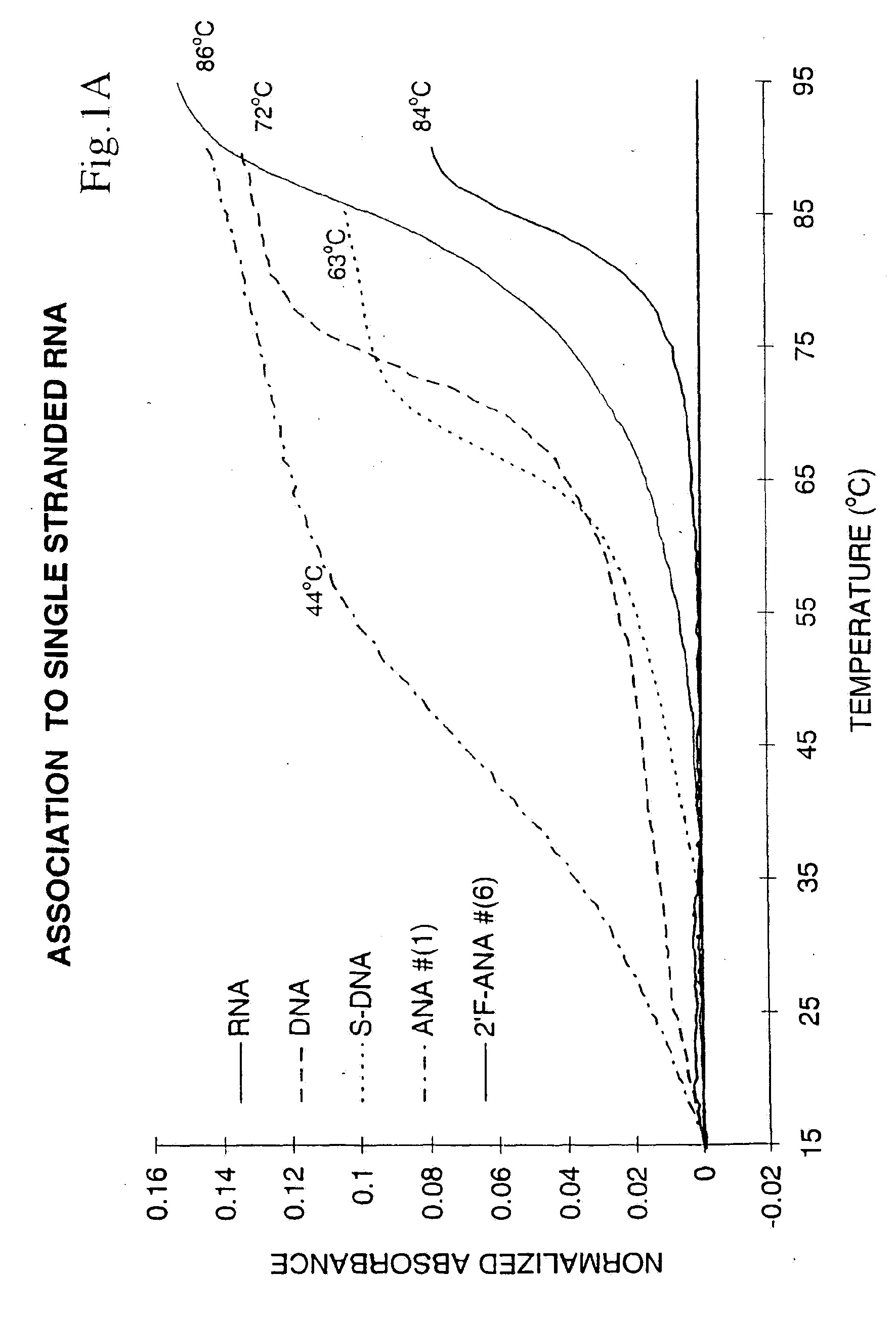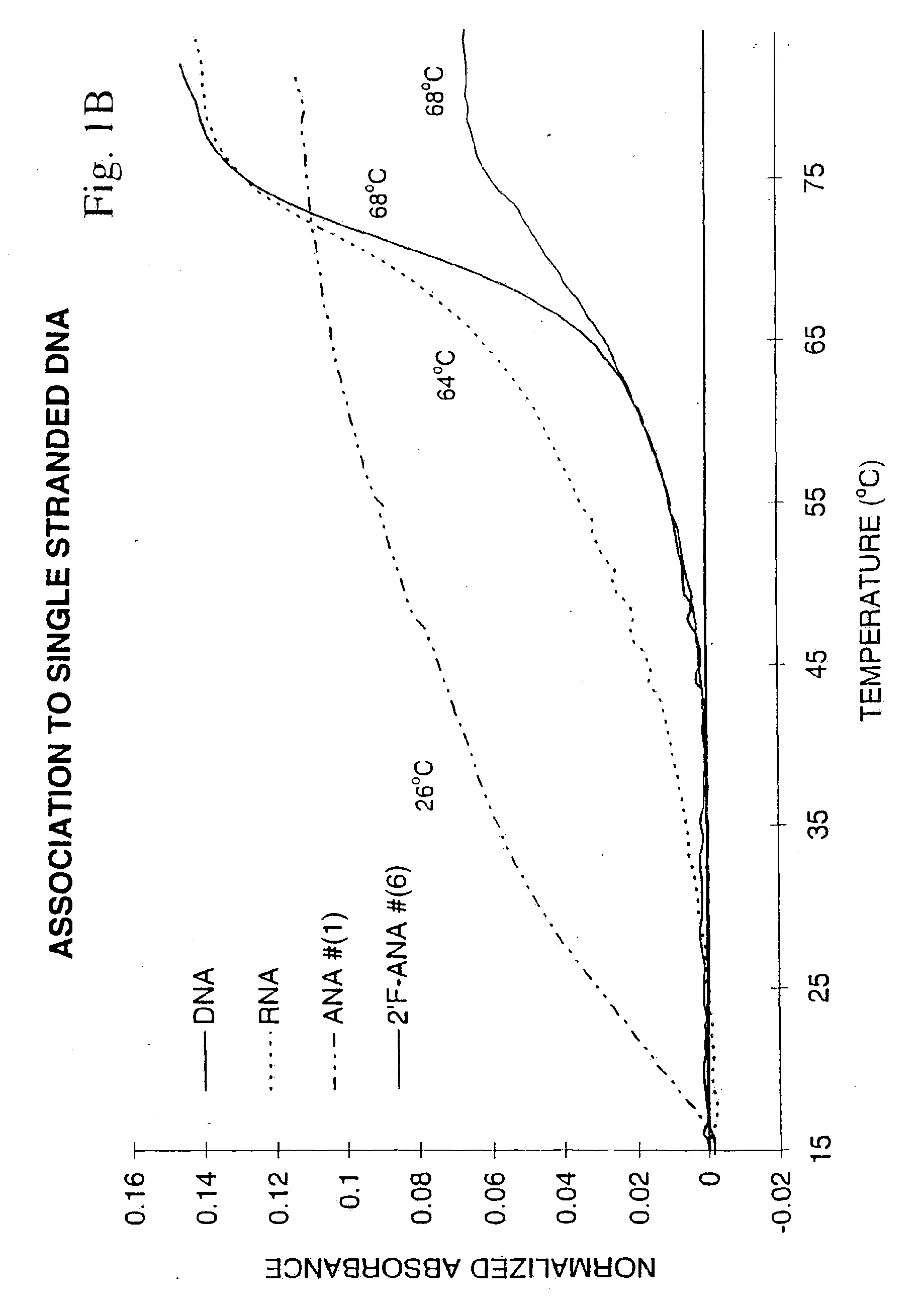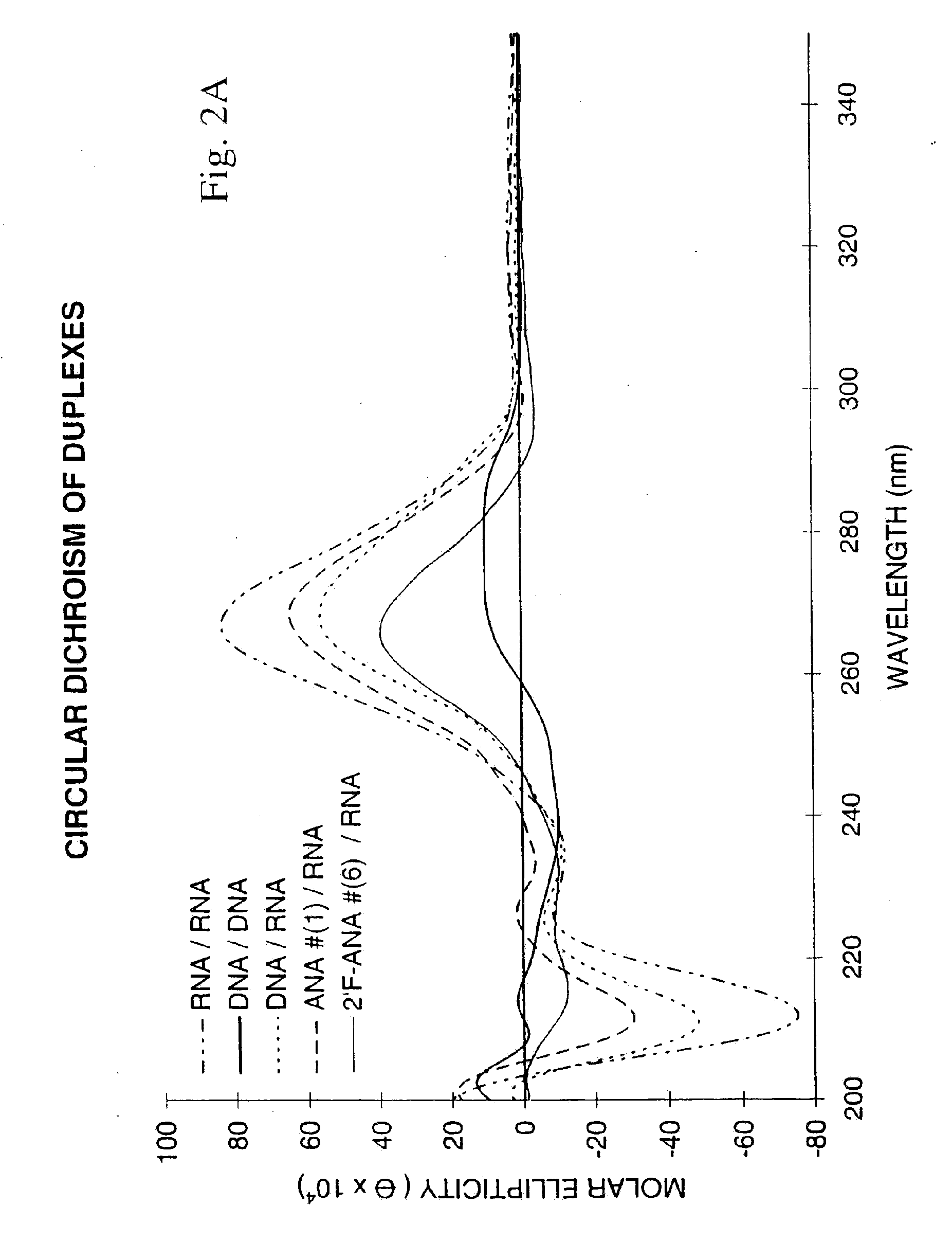Antisense oligonucleotide constructs based on beta-arabinofuranose and its analogues
a technology of beta-arabinofuranose and antisense oligonucleotide, which is applied in the direction of peptide/protein ingredients, biochemistry apparatus and processes, sugar derivatives, etc., can solve the problems of limiting the therapeutic utility of ps-aon, and ps-aons are less efficient at inducing rnaseh degradation of the target rna than
- Summary
- Abstract
- Description
- Claims
- Application Information
AI Technical Summary
Benefits of technology
Problems solved by technology
Method used
Image
Examples
example 1
Preparation of Oligonucleotides Containing β-D-Arabinofuranoses
[0054]Oligoarabinonucleotides (Formula I; X═OH, Y═O−) were synthesized using standard phosphoramidite chemistry and 3′-ara-C(Bz)-long-chain alkylamine controlled pore glass solid support (lcaa-CPG; 500 Å; 1 μmol scale). The required monomers, namely 5′-MMT-2′-OAc-3′-O—(β-cyanoethyl-N,N-diisopropylphosphoramidite) derivatives of ara-A(Bz), ara-C(Bz) and ara-U were synthesized by the method of Damha et al. (Damha, M. J.; Usman, N.; Ogilvie, K. K., Can. J. Chem. 1988, 67, 831; Giannaris, P. A.; Damha, M. J.; Can. J. Chem. 1994, 72, 909). The corresponding ara-G (N2-i-Bu, O6-NPE) monomer was prepared by a modification of the procedure of Resmini et al. (Resmini, M.; Pfleiderer, W. Helv. Chim. Acta 1994, 77, 429). Thus, the monomers were dissolved to 0.12 M in anhydrous acetonitrile. Prior to chain assembly, the support (1 μmol) was treated with the capping reagents, acetic anhydride / N-methylimidazole / 4-dimethylaminopyridine ...
example 2
Preparation of Oligonucleotides Containing 2-Deoxy-2-Fluoro-β-D-Arabinose Sugars
[0056]Oligoarabinonucleotide synthesis (Formula I; X═F, Y═O−) was performed on an Applied Biosystem DNA synthesizer (model 381A) using the phosphoramidite approach. Oligomers were prepared on a 1.0 μmol scale using lcaa-CPG solid support bearing 3′-terminal 2′-deoxy-2′-fluoro-β-D-arabinonucleosides. Coupling yields ranged from 60 to 100% (average ca. 80%) as monitored by the release of the MMT cation. The required 3′-O—(β-cyanoethyl-N,N-diisopropylphosphoramidite) derivatives of 5′-MMT-2′-deoxy-2′-fluoro-β-D-arabinonucleosides (2′F-ara-C, 2′F-ara-A, 2′F-ara-G and 2′F-ara-T) were synthesized by published procedures (Tann, C. H.; Brodfuehrer, P. R.; Brundidge, S. P.; Sapino, C. Jr.; Howell, H. G. J. Org. Chem. 1985, 50, 3644; Howell; H. G.; Brodfuehrer, P. R.; Brundidge, S. P.; Benigni, D. A.; Sapino, C., Jr. J. Org. Chem. 1988, 53, 85; Kois, P.; Tocik, Z.; Spassova, M.; Ren, W.-Y.; Rosenberg, I.; Farras S...
example 3
Association Properties of Uniformly Modified Oligonucleotides Possessing β-D-Arabinose and β-D-2-Fluoro-2-Deoxyarabinose Sugars
[0057]Binding to Single Stranded DNA and RNA Targets
[0058]The ability of oligonucleotides to hybridize to single-stranded nucleic acids to give a double-helical complex is crucial for their use as antisense therapeutic agents. The formation of such a complex involves stacking and hydrogen bonding interactions between the base chromophores, a process which is accompanied by a reduction in UV absorption (“hypochromicity”). When the temperature of the solution containing the double-helical complex is gradually raised, the hydrogen bonds break and the duplex dissociates into single strands. This reduces the amount of base-base interactions and hence leads to a sudden increase of the UV absorbance. The temperature at which the double-helical complex dissociates, or more precisely, the point at which half the population exists as complex and the remaining half as ...
PUM
| Property | Measurement | Unit |
|---|---|---|
| Molar density | aaaaa | aaaaa |
| Molar density | aaaaa | aaaaa |
| Molar density | aaaaa | aaaaa |
Abstract
Description
Claims
Application Information
 Login to View More
Login to View More - R&D
- Intellectual Property
- Life Sciences
- Materials
- Tech Scout
- Unparalleled Data Quality
- Higher Quality Content
- 60% Fewer Hallucinations
Browse by: Latest US Patents, China's latest patents, Technical Efficacy Thesaurus, Application Domain, Technology Topic, Popular Technical Reports.
© 2025 PatSnap. All rights reserved.Legal|Privacy policy|Modern Slavery Act Transparency Statement|Sitemap|About US| Contact US: help@patsnap.com



